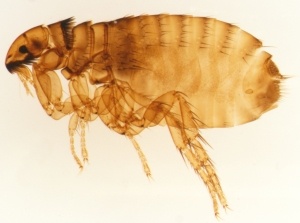Flea Treatments
Fleas

Cat Flea
The life cycle of the flea is similar to that of a moth - egg, larva (caterpillar), pupa (cocoon) and adult. A newly hatched adult flea is unfed, small, black and aggressive: the larger adult fleas have had a blood meal and may be laying eggs on your pet. For every flea on your pet, there may be hundreds waiting to emerge.

Householders sometimes believe flea treatments are ineffective because the pupae are quite resistant to chemical treatment and fleas continue to emerge from pupal cases even after being treated. Ten fleas can potentially reproduce to 250,000 in only 30 days.
Latest research shows that adult fleas do not leave the pet to lay eggs. The white eggs are laid on the pet and fall onto the ground, carpet etc. The eggs hatch and small, blind larvae emerge. These larvae move away from the light, burrowing down into the carpet, cracks in the floor or soil. Here they feed on protein, such as flea droppings of partly digested blood, and moult three times before pupating. The larva changes into the adult in the pupa.
When this metamorphosis is complete, the flea is ready to emerge. Fleas can remain dormant in the pupal stage for over 18 months. Hatching of the flea from the pupa is triggered by movement nearby predominantly during warm, moist weather conditions.
The newly hatched unfed flea is small and black (it is sometimes incorrectly referred to as a ground flea). After feeding on its host for two days, now bigger and lighter in colour, it is ready to mate and lay eggs. The female flea is capable of laying up to 500 eggs over a lifetime which may span several weeks.
Flea Treatments
A successful flea treatment must include all the areas frequented by the pet.
1) Indoors- remove toys, clothes etc from the floor. Some insecticides will affect fish. Cover fish tanks and turn off the filter prior to treatment. Remove pets from the area to be treated -- return them only after treatment has dried.
2) Treat the pet(s) -- advice may be sought from your veterinarian. The use of soaps and shampoos may reduce the residual action of the treatment.
3) Be patient. Even if everything has been done correctly, you will still see newly hatched fleas, usually for several weeks. Do not leave the flea infested areas undisturbed -- movement hatches the fleas! Do not vacuum for at least seven days after a treatment, place vacuum bag in the bin.
4) Leave your pet in the flea infested areas of the house, it will attract the fleas. If your pet is removed from the infested areas, fleas will continue to hatch for about 6 weeks with normal "human "activity. Retreat your pet regularly according to the label of the on-animal flea product.
Request A Quote
Termite Control Credentials
- Trade Contractor licence QBSA 735076
- QLD Health Licence 3662
- Tafe Certficate in Urban Pest Control
- Tafe Certificate III in Asset Maintenance
- Certificate in Termite Colony Control
- Certificate in Termite Inspection
- Certificate in Termiticide Application
- Licensed Termatrac Inspector
- Accredited TermX Installer
- Accredited Termidor Applicator
- Accredited Timber Secure Provider
- General Liability Cover $5,000,000
- Professional Indemnity Cover $500,000
- Accredited HomeGuard Installer
- Eflex Accredited
- Term-seal Accredited









